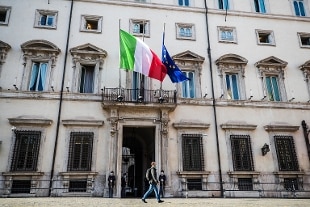Recovery: Draghi-ministers summit on Pnrr, green light for interventions for 221.5 billion
Recovery: Portugal is the first EU country to present the national plan in Brussels
Recovery: Prime Minister Draghi tightens on the PNRR.
Point with the ministers before landing in the Chambers
Recovery plan, Draghi to trade unions: "It will be 221.5 billion, Council of Ministers this week"
Palazzo Chigi, Recovery to the EU on 30 April: road map confirmed
Recovery, Dombrovskis: Better to have good plans than to hurry
Share
April 23, 2021 The 221 billion national recovery plan arrives in the council of ministers for an initial examination, then the move to Parliament next week before final approval.
Mario Draghi brings to the Council of Ministers a National Recovery and Resilience Plan worth a total of 221.5 billion, of which 191.5 referable to the Recovery Fund and 30 billion to finance "extra Recovery" works. The estimated boost to growth is 3 points of GDP in 2026.
The goal is not only to "repair the damage of the pandemic" but also to tackle "structural weaknesses" in the Italian economy. The bulk of the plan is defined, with 135 lines of investment. And the plant "will not change", underline by the government, in the face of the mass of requests emerging from the parties in these hours.
The numbers
The new Recovery Plan has confirmed the structure in six missions and 16 components. For
Digitization, innovation, competitiveness and culture
42.55 billion are expected (38.25 for new projects), for
Green Revolution and ecological transition
57 (34.6), for
Infrastructures for sustainable mobility
25.33 (14.13), for
Education and research
31.88 (24.1), for
Inclusion and cohesion
19.12, for
Health
15.63 (12.65). Figures that lead to a total of 191.5 billion.
Among the funds financed with EU resources, the intervention of about 5 billion in support of the cashback operation is missing to favor digital payments. Instead, the main lines of intervention with respect to the old plan are confirmed. Like the tax incentives of the Transition 4.0 plan with 18.5 billion and the ultra-broadband that is further expanded and brought to 5.3 billion, 4 of which for new projects.
Average
GDP
growth
in 2022-26 it will be 1.4 points higher than in the 2015-2019 period and in 2026 the GDP will be 3 percentage points higher than in the baseline scenario (without the NRP). The draft of the Recovery plan reads: increasing productivity through innovation, digitization, investment in human capital is the objective of the Plan, together with support for the cyclical recovery which must be "more robust and more sustained".
The
governance
for the Recovery plan for the implementation it provides for direct responsibility of the operating structures involved: ministries, local and territorial bodies for "carrying out investments and reforms within the agreed time frame; for the regular, correct and effective management of resources". We read in the draft of the Plan which also provides for monitoring, reporting and transparency "centered on the Ministry of Economy which monitors and controls the progress in the implementation of reforms and investments and acts as a single contact for communications with the European Commission".
No EU report and longer times
No reporting obligation to the European Commission and longer deadlines, compared to 2026 of the recovery plan time horizon. This is one of the differences between the government's investment plan through the complementary fund to the NRP and the National Recovery and Resilience Plan, indicated in a summary on the Recovery draft.
Justice reforms and procurement code
Two structural reforms - justice and public administration - to carry out the six missions which comprise the Recovery plan developed by the Italian government. On the justice front, in particular, the aim is to intervene on the "low efficiency" resulting from the excessive length of trials and the "heavy weight of judicial arrears". Among the "enabling reforms" to be implemented, "simplifications for the granting of permits and authorizations" as well as "interventions on the procurement code". Among the "sector-specific" reforms are then indicated "new rules for the production of renewables" and "interventions on the program contract for Railways".

